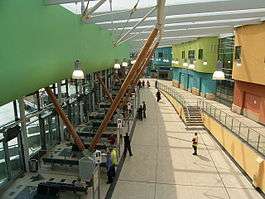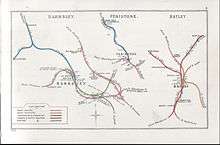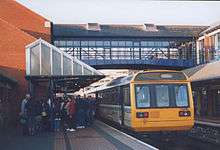Barnsley Interchange
| Barnsley Interchange | |
|---|---|
 | |
| Location | |
| Place | Barnsley |
| Local authority | Barnsley |
| Coordinates | 53°33′15″N 1°28′39″W / 53.554080°N 1.477590°WCoordinates: 53°33′15″N 1°28′39″W / 53.554080°N 1.477590°W |
| Grid reference | SE347065 |
| Operations | |
| Station code | BNY |
| Managed by | Northern |
| Number of platforms | 2 |
| DfT category | C2 |
|
Live arrivals/departures, station information and onward connections from National Rail Enquiries | |
| Annual rail passenger usage* | |
| 2012/13 |
|
| – Interchange |
|
| 2013/14 |
|
| – Interchange |
|
| 2014/15 |
|
| – Interchange |
|
| 2015/16 |
|
| – Interchange |
|
| 2016/17 |
|
| – Interchange |
|
| Passenger Transport Executive | |
| PTE | Travel South Yorkshire |
| Zone | Barnsley |
| History | |
| Key dates | Opened 1850 |
| Original company | Sheffield, Rotherham, Barnsley, Wakefield, Huddersfield & Goole Railway |
| Pre-grouping | Lancashire and Yorkshire Railway |
| Post-grouping | London, Midland and Scottish Railway |
| 1 January 1850 | Opened as Barnsley |
| 2 June 1924 | Renamed Barnsley Low Town |
| 1 August 1924 | Renamed Barnsley Exchange |
| 13 June 1960 | Renamed Barnsley |
| 20 May 2007 | Renamed Barnsley Interchange |
| National Rail – UK railway stations | |
| * Annual estimated passenger usage based on sales of tickets in stated financial year(s) which end or originate at Barnsley Interchange from Office of Rail and Road statistics. Methodology may vary year on year. | |
|
| |
Barnsley Interchange (formerly Barnsley Exchange station) lies in the centre of the town of Barnsley, in South Yorkshire, England. The station was opened in 1850 and is 16 miles (26 km) north of Sheffield. It is on the Hallam and Penistone Lines, both operated by Northern.
Earlier history

The Sheffield, Rotherham, Barnsley, Wakefield, Huddersfield & Goole Railway was formed in 1846 with the aim of providing access to the South Yorkshire coalfield. It was to link the Manchester and Leeds Railway (M&LR) near Horbury, with the Sheffield and Rotherham Railway near Brightside, by way of Barnsley. Whilst the railway was still at the planning stage, it was split in two at Barnsley, the northern portion being leased to the M&LR and the southern to the South Yorkshire, Doncaster & Goole Railway (SYD&G). The northern section opened first, and Barnsley station was opened with the line on 1 January 1850. The route of the southern section was changed, and instead, is connected to the SYD&G line near Mexborough. This section opened on 1 July 1851, and Barnsley then became a through station, although the two sections of line were operated by different railways. On 1 July 1854, the Manchester, Sheffield and Lincolnshire Railway (MS&LR) opened a line from Penistone to Barnsley.[1][2][3]
Each of these railway companies went through various takeovers and amalgamations, until the early 20th century, when the station at Barnsley was co-owned by the Lancashire and Yorkshire Railway (LYR, successor to the M&LR), and the Great Central Railway (GCR, successor to the MS&LR and SYD&G). At the 1923 grouping, the GCR became part of the London and North Eastern Railway (LNER), whilst the LYR formed part of the new London, Midland and Scottish Railway (LMS), as did the Midland Railway (MR). The LYR and MR each contributed one station in Barnsley to the LMS, and since the ex-MR station was already distinguished as Barnsley Court House, the LMS renamed the former LYR station to Barnsley Low Town on 2 June 1924. Just two months later, on 1 August 1924, it was again renamed, this time to Barnsley Exchange.[3]
Barnsley Court House station closed on 19 April 1960, following the commissioning of a new chord line south of the town near Quarry Junction that linked the former SYR route down the Blackburn Valley with the ex-Midland Railway line from Sheffield Midland, allowing services on the latter route to serve the station (and continue northwards to Wakefield & Leeds). Subsequently, on 13 June 1960, Barnsley Exchange was renamed Barnsley.[3]
Facilities

The station is fully staffed throughout the day, with the booking office open from 06:00 to 19:30 Mondays to Saturdays and from 08:45 to 19:00 on Sundays. A single self-service ticket machine is also provided for use outside these times and for collecting advance purchase tickets, located on the platform 2 side of the foot-bridge. In the main building on platform 1, there is a waiting room and toilets. A separate waiting room (with vending machines for drinks and snacks) is located on platform 2, with a fully accessible footbridge (equipped with lifts) linking them; there is step-free access from the entrance and bus station to all platforms. Train running information is provided by automated announcements, digital display screens and timetable posters. There are a number of shops a short walk over the footbridge to the bus station, these include a newsagents, Lloyds Pharmacy, Coopland Bakery and a Subway restaurant.[4]
In popular culture
In 2013 it was used as a filming location in Channel 4's cult drama series Utopia.[5]
Barnsley Interchange rail services

Rail services operate frequently through Barnsley Interchange station. On the Hallam line during the day on Monday to Saturday, there are three trains per hour northbound bound for Leeds. Two are express services, calling only at Wakefield Kirkgate en route to Leeds whilst the third is an all-stations local that runs via Castleford. There is one train per hour (express) and a two-hourly stopping service on Sundays.[6]
On the Penistone line, there is an hourly service northbound to Huddersfield from Monday to Saturday and a two-hourly service on Sundays (gradually increasing to hourly as part of Northern's commitment to improve service frequencies). Barnsley also marks the last continuous dual running track (except for parts) for trains heading towards Huddersfield, or the first continuous dual running track for trains heading towards Sheffield from Huddersfield.
Southbound there are four trains per hour (2 fast and 2 stopping). Two of these services terminate at Sheffield whilst one fast train carries on to Nottingham and the other fast service runs through to Lincoln Central (runs fast to Sheffield and then stopping service from Sheffield to Lincoln). The service drops to two or three per hour (one fast & two stopping) on Sundays.
Other Services One Sunday morning Train from Nottingham goes to Carlisle railway station via Leeds and the Settle to Carlisle line. Some trains start from Huddersfield and terminate at Lincoln Central.
From winter 2019, Barnsley Interchange will begin to be served by an hourly service to Lincoln Central via Sheffield and Retford, under a new Northern Connect brand, using brand new trains with WiFi. From here on, services to Nottingham will cease current operations, transferring to operate via Wakefield Westgate and a reduced stop on the Erewash Valley Line. Northern have stated the Leeds to Sheffield fast service will be of the same frequency with the new Lincoln Central service which will call at Wakefield Kirkgate and Meadowhall Interchange as the current services do. Normal interchange with Nottingham bound services will continue to be available at Sheffield.
In May 1999, Midland Mainline commenced a daily weekday service to London St Pancras.[7][8] The service was withdrawn by East Midlands Trains on 5 September 2008.[9]
| Preceding station | Following station | |||
|---|---|---|---|---|
| Northern Hallam Line | ||||
| Northern Penistone Line | ||||
| Northern Leeds-Nottingham | ||||
| Northern Leeds-Lincoln |
Barnsley Interchange bus services
The new Barnsley Interchange was opened on 20 May 2007 by Secretary of State for Transport Douglas Alexander. The new building forms the entire new complex of Barnsley Interchange. Rail and bus users exit the interchange via the new car park or, for the town centre, the new entrance and exit is on Eldon Street. It has 21 stands, with 3 coach stands.
The bus station features the latest in technology such as the South Yorkshire Passenger Transport Executive scheme of "Your Next Bus", tracking buses with GPS to check what time they are due to arrive and depart. Several shops occupy retail units within the interchange, including Lloyd's Pharmacy, GT News, Cowpuccino Espresso Bar, Cooplands and a Subway.
Work has since been completed on the link road, Schwäbisch Gmünd Way (formerly Interchange Way), which was renamed in honour of Barnsley's twin town in Germany. That enables buses to enter or leave the Interchange quickly, without having to use the busy level crossing at Jumble Lane.
Stagecoach Yorkshire operate most of the services from the Interchange, and Waterson's also operating services from the station. Stagecoach operate local routes throughout Barnsley and also to Wakefield, Pontefract, Doncaster, Rotherham, Sheffield and Leeds. Local routes go as far north as Wooley and as far south as Elsecar.
References
- ↑ Marshall, John (1969). The Lancashire & Yorkshire Railway, volume 1. Newton Abbot: David & Charles. pp. 214–5, 217–8. ISBN 0-7153-4352-1.
- ↑ Dow, George (1959). Great Central, Volume One: The Progenitors, 1813-1863. Shepperton: Ian Allan. pp. 150, 228. ISBN 0-7110-1468-X.
- 1 2 3 Butt, R.V.J. (1995). The Directory of Railway Stations. Yeovil: Patrick Stephens Ltd. p. 28. ISBN 1-85260-508-1. R508.
- ↑ Barnsley Interchange station facilities
- ↑ "Where Was Utopia Series 2 filmed? Our Production Services Team Have The Answers..." Creative England. 14 July 2014.
- ↑ GB National Rail Timetable December 2016, Table 34
- ↑ "MML serves 6 new stations" Rail Magazine issue 355 21 April 1999 page 10
- ↑ "Barnsley-London direct" Rail Express issue 36 May 1999 page 8
- ↑ "End of the line for Barnsley-London service" Today's Railways issue 83 November 2008 page 14
External links
| Wikimedia Commons has media related to Barnsley Interchange. |
- Train times and station information for Barnsley Interchange from National Rail
- Travel South Yorkshire website